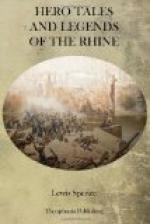But what, asks someone, is really the brightest gem of Rhineland poetry? while someone else adds that the majority of the writers cited above are but little known, and inquires whether none of the great German authors were ever inspired to song by their beloved river. The name of Heinrich Heine naturally comes to mind in this relation—comes to mind instantly on account of what is surely his masterpiece, Die Lorelei—a poem already dealt with.
But Heine’s version far transcends all others, and pondering on its beauty, we think first of its gentle, andante music, a music which steals through the senses like a subtle perfume:
Ich weiss nicht was
soll es bedeuten,
Dass ich so traurig
bin;
Ein Maerchen aus alten
Zeiten,
Das kommt mir nicht
aus dem Sinn.
There, surely, is a sound as lovely as the fateful maiden herself ever sang; and here, again, is a verse which is a tour de force in the craft of landscape-painting; for not only are the externals of the scene summoned vividly before the reader’s eyes, but some of the mystery and strangely wistful appeal of nature are likewise found in the lines:
Die Luft ist kuehl und
es dunkelt
Und ruhig fliesst der
Rhein;
Der Gipfel des Berges
funkelt
Im Abendsonneaschein.
CHAPTER III—CLEVES TO THE LOeWENBURG
Lohengrin
The tale or myth of the Knight of the Swan who came to the succour of the youthful Duchess of Brabant is based upon motives more or less common in folklore—the enchantment of human beings into swans, and the taboo whereby, as in the case of Cupid and Psyche, the husband forbids the wife to question him as to his identity or to look upon him. The myth has been treated by both French and German romancers, but the latter attached it loosely to the Grail legend, thus turning it to mystical use.
As a purely German story it is found at the conclusion of Wolfram von Eschenbach’s Parzival,[1] from which the following version is drawn. The name of the hero as written by Wolfram (Loherangrin) may possibly be traced to Garin le Loherin or Garin of Lorraine. Wagner’s version is taken from the same source, but the mighty master of melody altered many of the details for dramatic and other reasons.
[Footnote 1: See my Dictionary of Medieval Romance, articles ‘Grail,’ ‘Parzival,’ ‘Perceval,’ and ‘Garin.’]
The principal French versions of the romance are Le Chevalier au Cygne and Helyas, and there are medieval English forms of these.[2]
[Footnote 2: Op. cit.]
The Knight of the Swan
In a dungeon in the castle of Cleves lay Elsa of Brabant, languishing in captivity. Her father, the Duke of Brabant, had ere he died appointed his most powerful vassal, one Frederick of Telramund, to be her guardian; but he, seeking only the advancement of his own ends, shamefully abused the confidence of his lord. Using his authority as Elsa’s guardian, he sought to compel her to become his wife, and threw her into prison to await the wedding-day, knowing well that none would dare to dispute his action.




